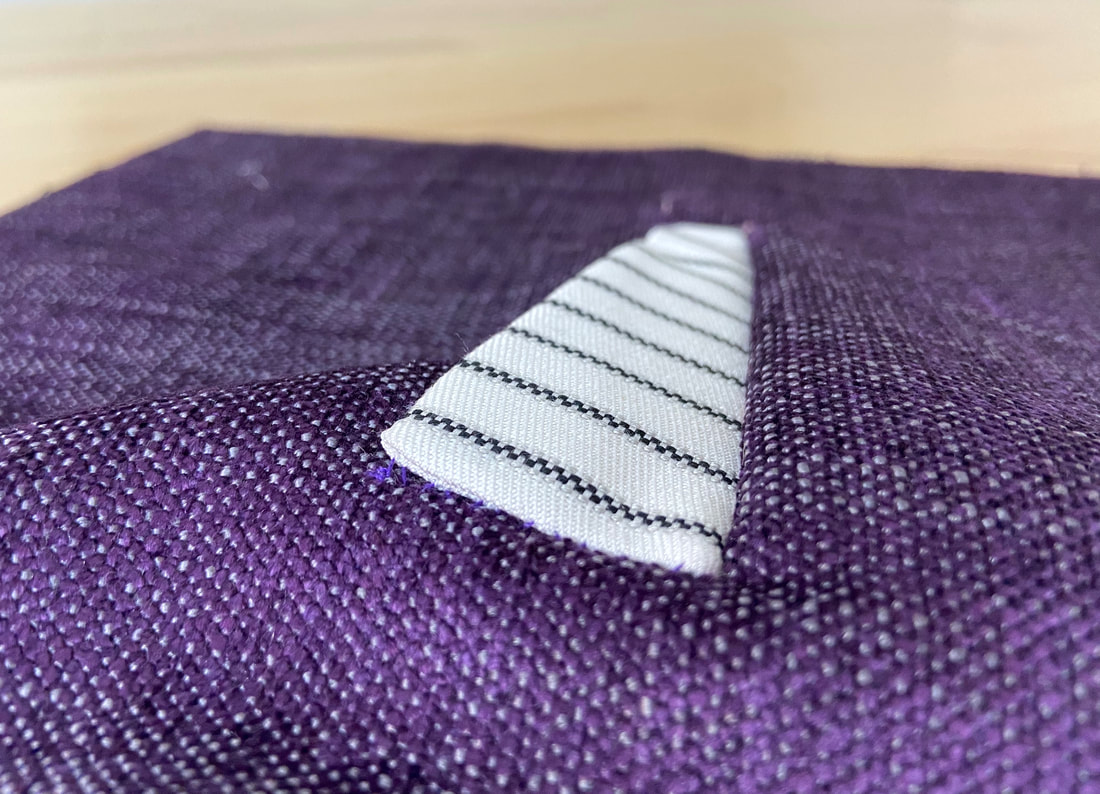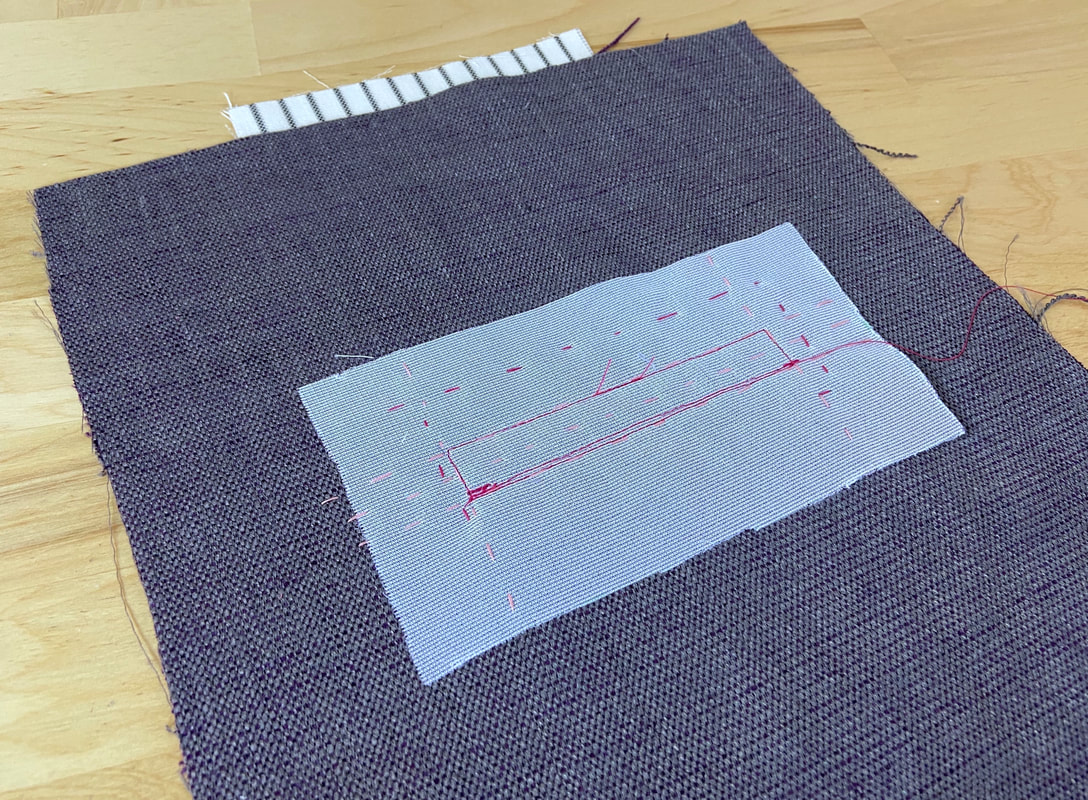A common technique for sewing a single welt pocket is completing the welt individually then attaching it to the slash pocket opening.
Instead of the ends of the welt being machine stitched within the slash opening, the welt is actually slipstitched by hand to each side of the pocket opening.
This technique is commonly used with textured, thick fabrics like heavy woolens and acrylics.
So why would you choose the hand-finished method as opposed to a simple self-welt for example? For one, slipstitching the welt piece to the face of the garment minimized bulk on its wrong side. That’s because the welt’s seam allowance edges are not directly stitched into the pocket opening edges. This is perhaps the main reason why a handstitched welt pocket technique is used with heavy, bulky coats.
This technique gives the final application a more three-dimensional effect by allowing the welt portion to stand out from the garment’s surface. It is also the only technique that allows you to sew a welt that has a different shape and depth than the pocket opening itself.
For example, a welt pocket that has a slanted edge, with one end being taller than the other, is achieved by using the slipstitched method described below.
In terms of length, if by design, the welt portion extends past the actual pocket opening (as opposed to only covering it), then a slipstitch is the only way to attach the welt.
As is true for any slash pocket, the wrong side of the garment layer needs to be interfaced at the location of the pocket prior to starting any of the sewing steps.
The welt portion in this case is treated much like a flap. It is interfaced and self-finished to enclose its raw edges at each end. Similar to a pocket flap, the welt portion is stitched to the top or bottom pocket opening edge during construction.
If you follow the steps below in consecutive order, you should find the whole process to be fairly simple and straight forward.
Sewing A Slant Single Welt Pocket: Blindstitched Technique
If you don’t already have a pattern, draft a simple pattern for the slanted welt piece as shown in the image below.
This slanted welt should have a center fold line. When the fabric is folded down this line, the self-finished welt is formed.
Don’t forget to add seam allowances along all edges. In this case, the seam allowance is 1/2” along the short edges, and 1/4" along the lengthwise edges.
You will also need two pocket bag pieces which is discussed in more detail below.
1. Cut one piece of the welt from the same fabric as the garment. Cut a matching piece of interfacing using the same pattern.
Trim the seam allowance off the interfacing piece and fuse it to the wrong side of the fabric in a centered position as shown.
2. Fold the welt piece lengthwise down the center with fabric face sides touching and all edges aligning. Insert pins perpendicular to each end of the welt.
3. Stitch the sides of the welt at ½” seam allowance.
4. Trim the seam allowances down to ¼” and notch the corners as shown.
5. Turn the welt on its face side and iron it in finished, folded position with its open edges aligning as shown.
6. Next, apply a layer of interfacing to the wrong side of the garment at the exact location of the pocket opening. The interfacing should be about 2” wider than the pocket opening on all sides.
7. On the right side of the garment, use hand basting to trace the exact pocket opening. Extend the lines past the opening at about 1” on all sides. Include a lengthwise center line as shown.
In this example, the pocket opening is 1/2” tall and 4” long.
8. Align the finished welt piece to the bottom hand basting line such that the welt’s raw edges are facing inward, toward the inside of the pocket rectangle. The welt seamline should align with the hand basted line as shown.
Hand baste the welt in this position.
9. Machine stitch the welt to the bottom pocket opening line (bottom hand basting).
Once complete, remove the welt basting at this point.
Additional to the finished welt, you should also have two additional pocket pieces to complete the pocket bag.
Follow the diagram below:
Follow the diagram below:
The larger piece should be 2” longer than the desired pocket depth (5") and 1” wider than the desired pocket width (4"): 5" x 7"
The shorter piece should be only 1/2” longer than the pocket depth (5") and again, 1” wider than the desired pocket width (4"): 5.5" x 5"
10. With the garment on its right side, place the larger pocket piece over the welt and rectangular basting such that its bottom edge is ½” away from the bottom basting line as shown. The welt is almost fully enclosed underneath this alignment.
Pin the pocket piece to the garment layer. For extra stability, hand baste it along its outer edges as shown.
11. Flip the garment on its wrong side, and following the rectangular hand basting, machine stitch through all layers underneath. When arriving at the existing welt stitch, stitch to the right of it. Doing so will ensure that no stitching is visible on the finished pocket application.
Once stitched, remove the temporary hand basting using a seam ripper.
12. Slash down the center of the rectangle stopping at about ½” from each end. At this point, carefully clip into each corner.
13. Flip the pocket layer to the wrong side of the garment. Straighten and iron to flatten the edges as shown.
14. Align the smaller pocket piece to the pocket's bottom seam allowance edge as shown.
Insert pins perpendicularly to secure the seam allowance edges.
15. Following the existing stitch, machine stitch through the seam allowances and smaller pocket layer underneath.
16. Flip the pocket application back on its wrong side, and iron the smaller (bottom) pocket layer and seam allowance edges down as shown.
17. Fold the top layer over the pocket opening and bottom layer such that all edges align. Insert pins perpendicular to the pocket bag edges to secure.
18. With the garment on its right side, peel the layers back on each side, and begin stitching the pocket bag starting at the base of the triangle cutout and moving down.
Continue stitching the pocket bag, pivoting up and stitching at the base of the other triangle extension.
Once complete, remove all the hand basting stitches using a seam ripper.
19. To complete the pocket bag, apply an overedge stitch to enclose its raw edges.
20. On the face of the garment, flip the finished welt up over the pocket opening and iron it in this position.
21. Slipstitch at each end of the welt to permanently connect it to the garment underneath. Use matching color thread- the stitching should be invisible on the right side if the garment.
Learn more about slipstitching in this tutorial: Hand-Applied Blind Stitches













































